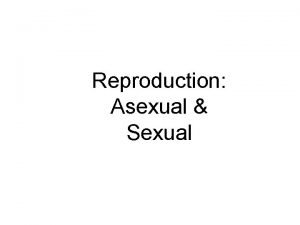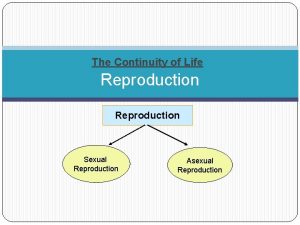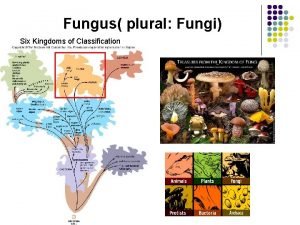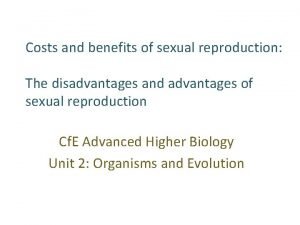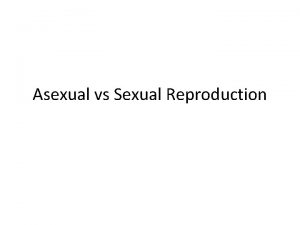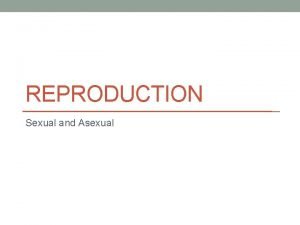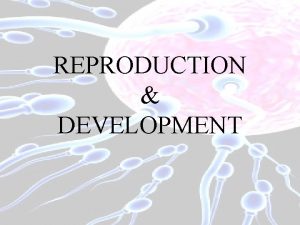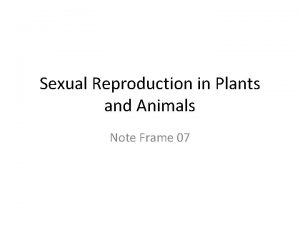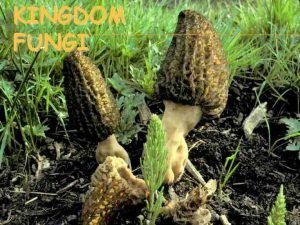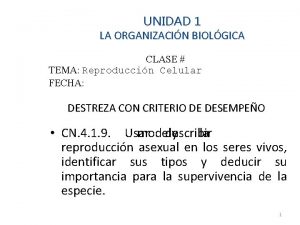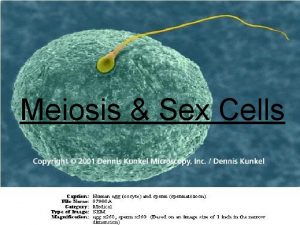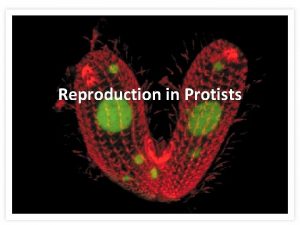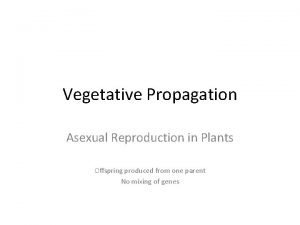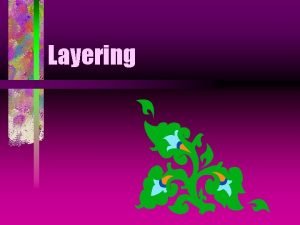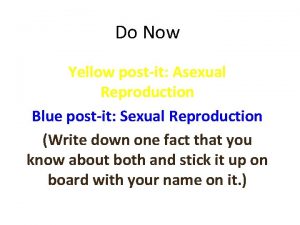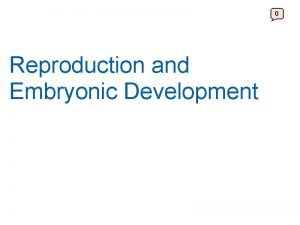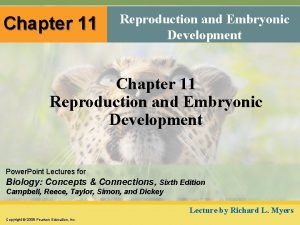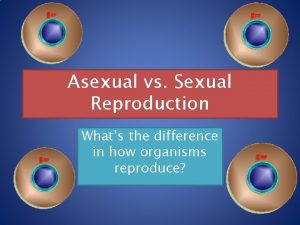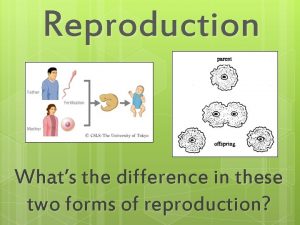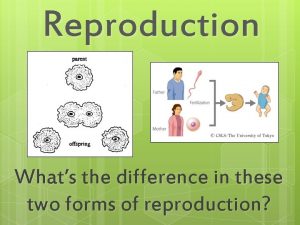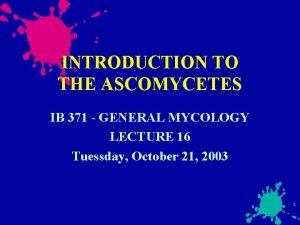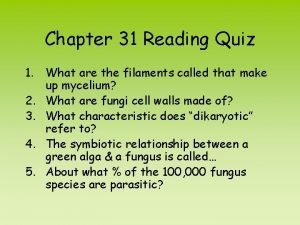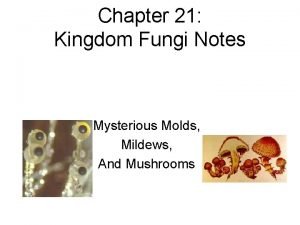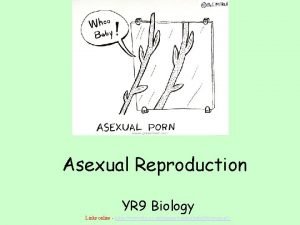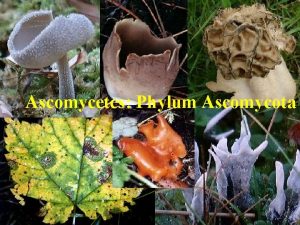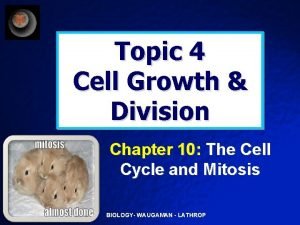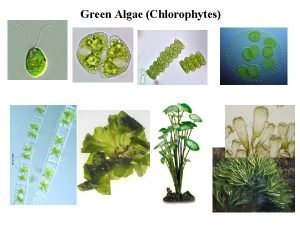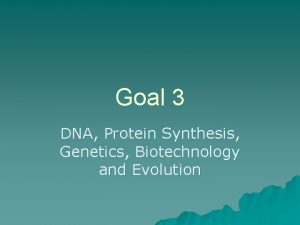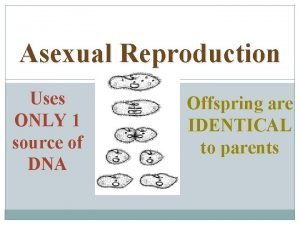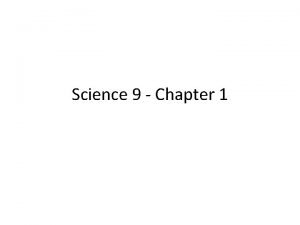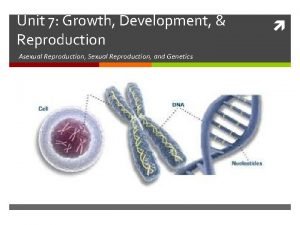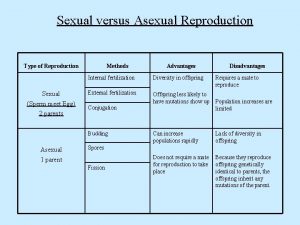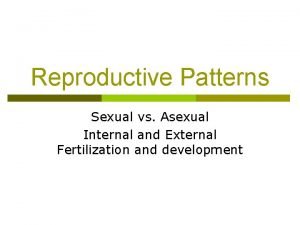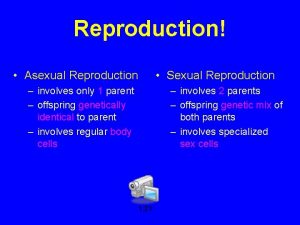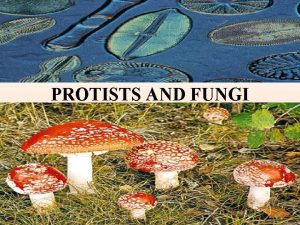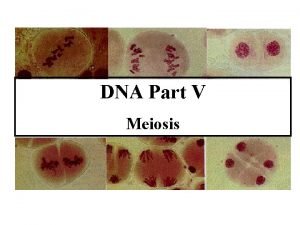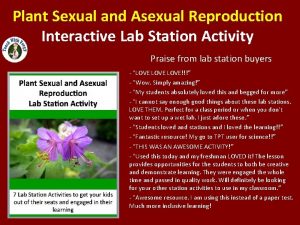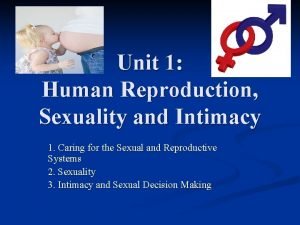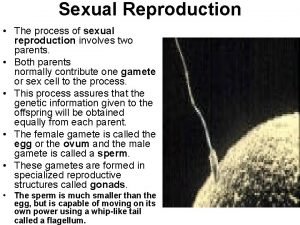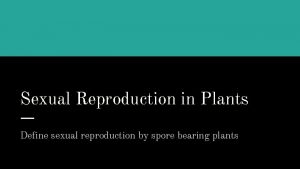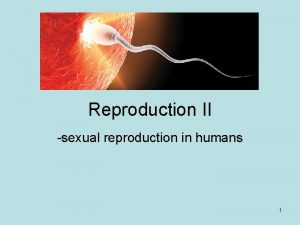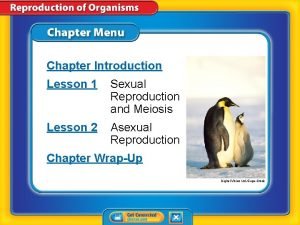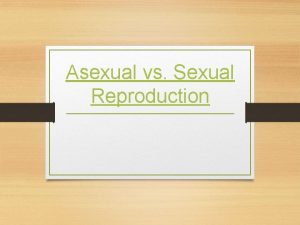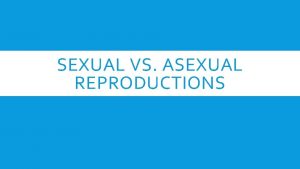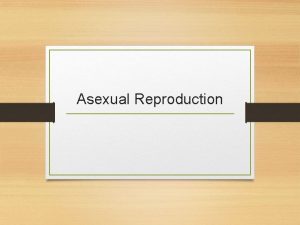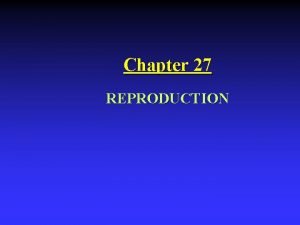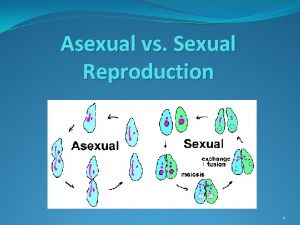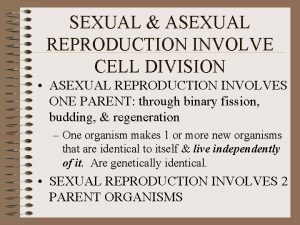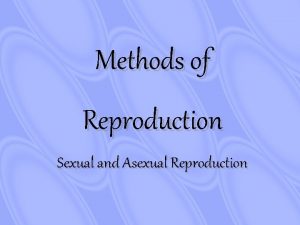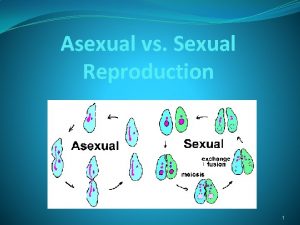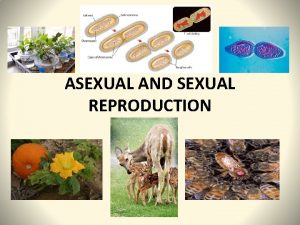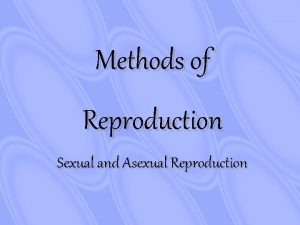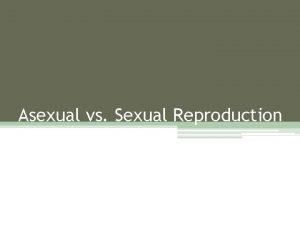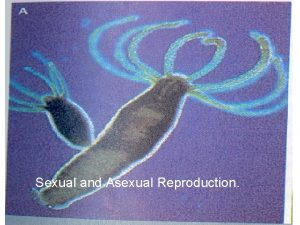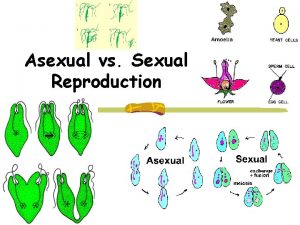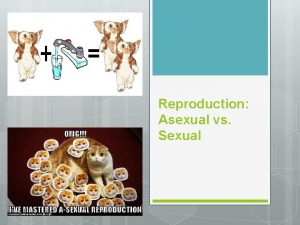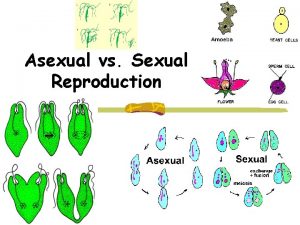Unit 7 Growth Development Reproduction Asexual Reproduction Sexual
































































- Slides: 64

Unit 7: Growth, Development, & Reproduction Asexual Reproduction, Sexual Reproduction, and Genetics

Bell Ringer 02/08/2016 Essential Question: How can I analyze my Unit 7 Pre – test for my strengths and weaknesses? Objectives: I can… analyze my Unit 7 Pre – test for my strengths and weaknesses Describe the relationship between DNA, genes, and chromosomes Bellringer: get a new bellringer sheet out of the purple container. Write week 23 on the top of the sheet. Copy and answer the following question in red on your sheet. How do you think you did on your Unit 6 Extended Response Question?

Agenda 1. Bellringer 2. Unit 6: ERQ results 3. Unit 7: Pre – test results and student reflection 4. Begin creating foldable for Gene structure notes

Unit 7 Pre-Test Scores LT 1 LT 3 LT 4 LT 5 LT 7 LT 8 LT 9 LT 10 #1 -2 #3 -10 #11 -14 #15 -19 #20 -21 #22 -23 #24 -25 #26 -29 2 = 5 pts 1 = 3 pts 0 = 1 pt 7 = 5 pts 6 -5=4 4 -3=3 2 -1 = 2 0 =1 4 = 5 pts 3 = 4 pts 2 = 3 pts 1 =2 pts 0 = 1 pt 4 = 5 pts 2 = 5 pts 3 = 4 pts 1 = 3 pts 2 = 3 pts 0 = 1 pt 1 = 2 pts 0 = 1 pt 2 = 5 pts 1 = 3 pts 0 = 1 pt 4 = 5 pts 3 = 4 pts 2 = 3 pts 1 =2 pts 0 = 1 pt

02/09/26 Snow Day

Bell Ringer 02/10/2016 Essential Question – What are the mechanisms of reproduction and heredity and how do they function to ensure continuity of life? Objective – I can… Describe where genes are located in a cell. Explain the structure and function of a gene. Bell Ringer - Copy and answer the following question (in red) on your bell ringer sheet: Where are our genes located?

Agenda 1. Go over bellringer 2. Watch video – Clearly Stated: What is a Gene? 3. Discussion Questions 4. Foldable notes on Structure and function of genes

Your Task Watch the video and write down as much information that you can about what a gene is composed of and its function. You may bullet your responses as you watch. What is a Gene? - Stated Clearly

So…What do you think is happening in the video? 1. How would you describe the structure of a gene? 2. What do you think those little clumps were at the end of the video?

The structure of DNA, genes & chromosomes Chromosomes Gene Cell Nucleus Protein

st 1 Flap: Chromosomes • Chromosomes are made of DNA. • Each contains genes in a linear order. • Human body cells contain 46 chromosomes in 23 pairs – one of each pair inherited from each parent

2 nd Flap: Chromatid Pair – When Chromatid Pair chromosomes from your mom and dad join, the pair resembles an “X”. Centromere Upon closer examination, chromosomes are made of fine thread – like substance called DNA. It is wound very tightly. Chromatid

3 rd Flap: DNA resembles a twisted ladder. The twisted ladder shape is called a double helix

The DNA Double Helix

Proteins • Genes are codes for cells to make proteins. • Proteins build things, like eye pigments, freckles, or mood altering hormones. • Proteins are like the recipe for the body’s characteristics.

4 th Flap: Base Pairs The “rungs” of DNA are made of bases. There are 4 bases: § A – Adenine § T – Thymine § C – Cytosine § G – Guanine. A’s only pair up with T’s C’s only pair up with G’s

DNA Base Pairs

Chromosomes Gene Cell Nucleus Protein

Bell Ringer 02/11/2016 Essential Question – What are the mechanisms of reproduction and heredity and how do they function to ensure continuity of life? Objective – I can… Describe where genes are located in a cell. Explain the structure and function of a gene. Describe the structure of DNA Bell Ringer - Copy and answer the following question (in red) on your bell ringer sheet: How many chromosomes are in a human body cell?

Agenda 1. Go over bellringer 2. Complete foldable notes on Structure and function of genes 3. Begin DNA – Double Helix worksheet

DNA Base Pairs

DNA: DNA resembles a twisted ladder This twisted ladder shape is called a double helix

Base Pairs: The “rungs” of the DNA are made of nitrogenous bases There are 4 bases: A, T, G, C A=Adenine, T=Thymine, G=Guanine C=Cytosine A only matches T C only matches G A gene is a section of base pairs

Snow Days Friday, February 12, 2016 Monday, February 15, 2016

Bell Ringer 02/16/2016 Essential Question – What are the mechanisms of reproduction and heredity and how do they function to ensure continuity of life? Objective – I can… Describe the structure of DNA Bell Ringer - Copy and answer the following question (in red) on your bell ringer sheet: Where is DNA located in a cell? (hint – look at your gene structure foldable)

Agenda 1. Go over bellringer 2. DNA – Double Helix worksheet 3. Begin homework

Your Task Color the DNA and RNA strand according to the directions. Answer the questions based on the reading If you do not finish, it is for homework!

Your Task Color the DNA and RNA strand according to the directions. Answer the questions based on the reading Finished? 1. Read pages 42 – 45 2. Complete section review questions 1 - 4 on page 45. Write out entire question and answer in complete sentences.

Bell Ringer 02/17/2016 Essential Question – What are the mechanisms of reproduction and heredity and how do they function to ensure continuity of life? Objective – I can… Describe the structure of DNA Bell Ringer - Copy and answer the following question (in red) on your bell ringer sheet: 1. What are the four nitrogen bases found in DNA? 2. Which base pairs bond together?

Agenda 1. Go over bellringer 2. Check homework - DNA – Double Helix worksheet 3. Go over worksheet 4. Bill Nye - Genes

Bell Ringer 02/18/2016 Essential Question – What are the mechanisms of reproduction and heredity and how do they function to ensure continuity of life? Objective – I can… Describe the structure of DNA Bell Ringer - Copy and answer the following question (in red) on your bell ringer sheet: 1. What are the sides of the DNA ladder made up of? (hint there are two chemicals)

Agenda Go over bellringer 1. • Check homework - DNA – Double Helix worksheet (5 th Period only) 2. Finish Bill Nye Video 3. Go over video worksheet 4. Begin DNA model

Bell Ringer 02/22/2016 Essential Question – What are the mechanisms of reproduction and heredity and how do they function to ensure continuity of life? Objective – I can… Describe the structure of DNA Describe the process of the cell cycle (interphase, mitosis, cytokinesis) Bell Ringer - Get a new bellringer sheet from the purple box on the demo counter. Write week 25. Copy and answer the following question (in red) on your bell ringer sheet: 1. If a nerve cell of a fly has 28 chromosomes, how many chromosomes would a fly egg cell contain?

Agenda Go over bellringer 1. • Collect bellringers – 2 nd period only 2. Begin DNA model 3. Complete questions 4. Begin multiplicity activity

DNA Model Materials: cleaners 3 - blue pipe 2 - black pipe cleaners 1 - index card 12 - white beads 3 - red pipe cleaners 1 - paper clip 3 - green pipe cleaners 3 - yellow pipe

DNA Model On your index card indicate the following: Phosphates Deoxyribose Adenine Guanine Cytosine Thymine ON THE BACKSIDE WRITE BOTH OF YOUR NAMES!!!!

Follow Up Questions 1. Identify the chemicals that make up the sides of the DNA double helix. 2. Identify the nitrogen bases that make up the rungs of the DNA double helix. 3. What is a nucleotide? 4. How does DNA code for a protein?

Bell Ringer 02/23/2016 Essential Question – What are the mechanisms of reproduction and heredity and how do they function to ensure continuity of life? Objective – I can… Describe the structure of DNA Describe the process of the cell cycle (interphase, mitosis, cytokinesis) Bell Ringer - Copy and answer the following question (in red) on your bell ringer sheet: Copy the diagram of the cell below. Label the cytoplasm, cell membrane, and nuclear membrane

Agenda Go over bellringer 1. • 2. Create DNA model and complete follow up questions – 2 nd period only Begin multiplicity activity

Multiplicity: Modeling the Cell Cycle Read through introduction Part I: Thinking Analogously 1. Remove “the toys” from the bag and spread them out on the paper towel. 2. Generate a method of separating the “toys” in an orderly fashion 3. Record your procedure on you student answer page. • Make sure to number your steps!

Multiplicity: Modeling the Cell Cycle Part II: Anticipating Mitosis What events have to occur for the daughter cells to have the same number chromosomes as the mother cell? 2. Develop a “schedule of events” or procedure for cell division and record your steps. 3. Use the words cytoplasm, cell membrane, and nuclear membrane in your steps 1. • Make sure to number your steps Think about the structure of the cell. Are there certain structures that are in the way or must change for cell division to occur?

Bell Ringer 02/24/2016 Essential Question – What are the mechanisms of reproduction and heredity and how do they function to ensure continuity of life? Objective – I can… Describe the process of the cell cycle (interphase, mitosis, cytokinesis) Bell Ringer - Copy and answer the following question (in red) on your bell ringer sheet: What are three stages of the cell cycle?

Agenda Go over bellringer 1. • • 2. Student Voice Survey – 2 nd period only Begin Multiplicity – 2 nd period only Part II and III of Multiplicity activity

Multiplicity: Modeling the Cell Cycle Part III: Modeling The Cell Cycle Follow Ms. Braman’s model of the cell cycle using paper chromosomes and string (in the envelopes). Each envelope should contain: 2 yellow centrioles 2 pink chromosomes 2 blue chromosomes 2 orange chromosomes 2 purple chromosomes 2 strings

Multiplicity: Modeling the Cell Cycle On your student answer page record: TABLE 1: An illustration and description of each of the important structures of the cell division TABLE 2: An illustration and summary of each of the stages of the cell cycle.

Table 1: Important Structures of the Cell Chromatin – The uncoiled DNA in the nucleus.

Table 1: Important Structures of the Cell Chromosome – The long, stringy, unwound chromatin coil and condense (shrink up) into thick threads of visible genetic material

Table 1: Important Structures of the Cell Sister Chromatid – Chromosomes have already been copied, forming sister chromatids. The sister chromatids are connected to each other at the centromere

Table 1: Important Structures of the Cell Centromere – The attachment point for the spindle fibers to the chromosome

Table 1: Important Structures of the Cell Centriole – Helps create and organize the mitotic spindle fibers

Bell Ringer 02/25/2016 Essential Question – What are the mechanisms of reproduction and heredity and how do they function to ensure continuity of life? Objective – I can… Describe the process of the cell cycle (interphase, mitosis, cytokinesis) Bell Ringer - Copy and answer the following question (in red) on your bell ringer sheet: 1. What stage of the cell cycle is the longest? 1. What stage of the cell cycle is the shortest?

Agenda Go over bellringer 1. • 2 nd period only – Complete table 1 2. Complete table 2 of Multiplicity activity. 3. Analysis and Conclusion Questions 4. Mitosis Summary

Table 2: Stages of Cell Division End of Interphase Centrioles The cell making proteins during this time. Chromatin Nuclear Membrane The chromatin is still uncoiled in the nucleus.

Table 2: Stages of Cell Division Spindle Fibers Centrioles Prophase – The long stringy chromatin starts to coil and condense into thick threads called chromosomes. The nucleus starts Chromosomes to disappear.

Table 2: Stages of Cell Division Metaphase – The centromeres of the sister chromatids line up along the center of the cell. Sister Chromatids Centromeres

Table 2: Stages of Cell Division Anaphase – The centromere of each chromosome divides, separating the sister chromatids from each other. The chromatids of each pair will be moved by the spindle fiber towards opposites poles of the cell. Chromosomes The separated chromatids are called chromosomes.

Table 2: Stages of Cell Division Nuclear Membranes Telophase – The final phase of mitosis occurs as new nuclear membranes are formed around both groups of chromosomes. The result is two separate nuclei, each containing the same amount of chromosomes as the original cell.

Table 2: Stages of Cell Division Cytokinesis – The last stage of the cell cycle in which the cytoplasm divides in animal cells. The start of cytokinesis starts with a cleavage furrow. The cell membrane is drawn inward until the cytoplasm is split into two separate parts, forming two distinct cells.

Your Task 1. Answer Analysis Questions on page 6 of your packet in complete sentences (for 1 and 2). 2. Answer Conclusion Question 2 on page 7 3. Summarize the parts of the cell cycle in your own words on the very back page. Be sure to use all of the terms located in Table 1 of your multiplicity packet. 4. Finished? 1. Read three science world magazine articles and summarize each article on a piece of notebook paper.

Bell Ringer 02/26/2016 Essential Question – What are the mechanisms of reproduction and heredity and how do they function to ensure continuity of life? Objective – I can… Describe the process of the cell cycle (interphase, mitosis, cytokinesis) Bell Ringer - Copy and answer the following question (in red) on your bell ringer sheet: 1. What are the four stages of mitosis in order?

Agenda Go over bellringer 1. • 2. 2 nd period only – Complete table 2 Complete Multiplicity analysis and conclusion questions.

2 nd Period Task 1. Complete Table 2 2. Complete Analysis Questions 1 – 3 Hint – for question 3 look at the number of chromosomes in table 2. 3. Complete Conclusion questions 2 - 6 on pages 7 – 9.

Your Task for Today 1. Answer Analysis Questions 3 - on page 6 of your packet in complete sentences. 2. Answer Conclusion Question 3 – 6 on pages 8 -9 3. If you didn’t complete this yesterday – • Summarize the parts of the cell cycle in your own words on the very back page. • Be sure to use all of the terms located in Table 1 of your multiplicity packet. 4. Finished? 1. Read three science world magazine articles and summarize each article on a piece of notebook paper.

Question 3 – Conclusion Questions Anaphase 1% Telophase 2% Metaphase 5% Prophase 14% Interphase 78%
 Venn diagram of sexual and asexual reproduction
Venn diagram of sexual and asexual reproduction Asexualk
Asexualk Asexual reproduction vs sexual reproduction venn diagram
Asexual reproduction vs sexual reproduction venn diagram Difference of sexual and asexual reproduction
Difference of sexual and asexual reproduction Asexual vs sexual reproduction
Asexual vs sexual reproduction Chromosome number of animals
Chromosome number of animals Asexual vs sexual reproduction venn diagram
Asexual vs sexual reproduction venn diagram Sexual or asexual reproduction
Sexual or asexual reproduction Fungus plural
Fungus plural Sexual or asexual reproduction
Sexual or asexual reproduction Sexual or asexual reproduction
Sexual or asexual reproduction Reproduction
Reproduction Asexual or sexual reproduction
Asexual or sexual reproduction Mitosis sexual reproduction
Mitosis sexual reproduction Sexual example
Sexual example Asexual and sexual reproduction difference
Asexual and sexual reproduction difference Difference between sexual and asexual reproduction
Difference between sexual and asexual reproduction Site:slidetodoc.com
Site:slidetodoc.com Characteristics of yeast
Characteristics of yeast Organizador grafico de la reproduccion sexual y asexual
Organizador grafico de la reproduccion sexual y asexual What is meiosis
What is meiosis Do protists reproduce asexually
Do protists reproduce asexually Vegetative propagation
Vegetative propagation Fission vs budding
Fission vs budding Platyhelminthes examples
Platyhelminthes examples Asexual propagation layering
Asexual propagation layering Types of asexual reproduction
Types of asexual reproduction Asexual reproduction
Asexual reproduction Asexual reproduction
Asexual reproduction Whats sexual reproduction
Whats sexual reproduction Chapter 19 asexual reproduction answer key
Chapter 19 asexual reproduction answer key Whats reproduction
Whats reproduction Whats reproduction
Whats reproduction Ascomycetes life cycle
Ascomycetes life cycle Chytridiomycota
Chytridiomycota Multicellular fungi are composed of thin filaments called
Multicellular fungi are composed of thin filaments called Budding asexual reproduction
Budding asexual reproduction Runner plant examples
Runner plant examples Ascomycota slide
Ascomycota slide How do plants reproduce
How do plants reproduce Asexual reproduction of budding
Asexual reproduction of budding Asexual reproduction of budding
Asexual reproduction of budding Green algae structure
Green algae structure Asexual reproduction of budding
Asexual reproduction of budding What type of reproduction
What type of reproduction Asexual reproduction involves *
Asexual reproduction involves * Animal and plant reproduction venn diagram
Animal and plant reproduction venn diagram Complete the sentences to summarize the article
Complete the sentences to summarize the article Asexual reproduction
Asexual reproduction Sea urchin phylum
Sea urchin phylum Types of asexual reproduction
Types of asexual reproduction Asexual reproduction involves
Asexual reproduction involves Asexual reproduction in fungi
Asexual reproduction in fungi Asexual reproduction
Asexual reproduction Prometaphase 2
Prometaphase 2 Asexual reproduction lab
Asexual reproduction lab Why is asexual reproduction beneficial
Why is asexual reproduction beneficial Sexual reproduction in human
Sexual reproduction in human Sexual reproduction
Sexual reproduction Sexual reproduction?
Sexual reproduction? Define sexual reproduction
Define sexual reproduction Section 1 meiosis
Section 1 meiosis Reproduction in humans
Reproduction in humans Chapter 10 sexual reproduction and genetics
Chapter 10 sexual reproduction and genetics Reproduction of organisms
Reproduction of organisms




